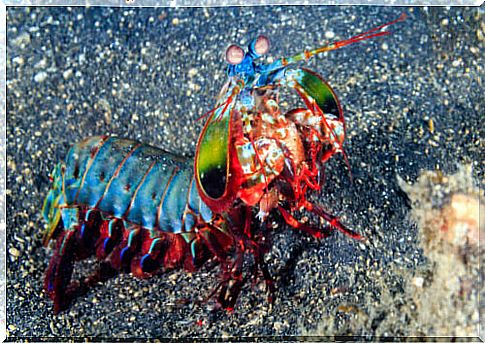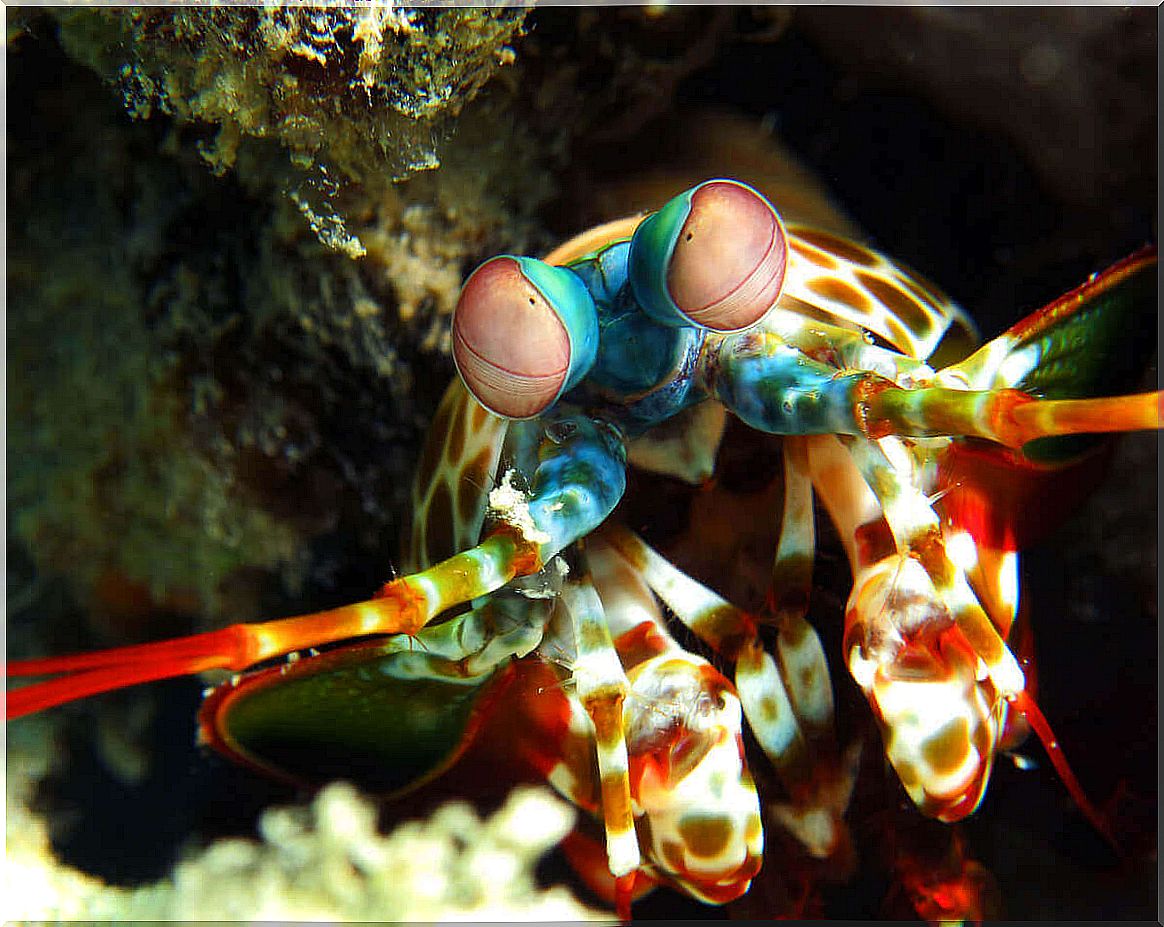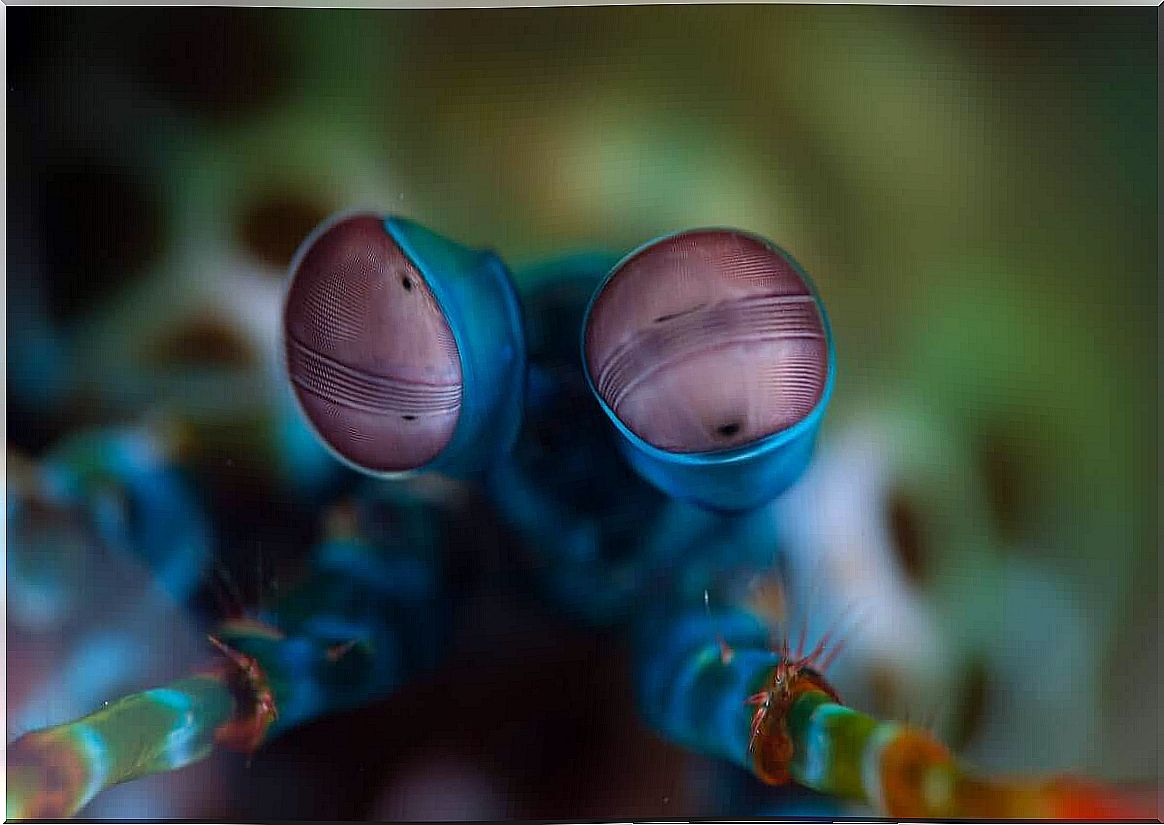The Invincible Mantis Shrimp – An Aggressive Hunter

Crustaceans come in many different sizes; this varies between 13 and 40 cm. They are also available in a wide variety of colors, there are brown types, those with stronger colors and some are even fluorescent. One of the most conspicuous species is the mantis shrimp.
These invertebrate crustaceans belong to the order of the Stomatopoda, which includes around 400 different species. All of these species also belong to the suborder Unipeltata . In general, we refer to them by a variety of names: sea locusts, shrimp killers, and even thumb splitters.
Mantis Shrimp: Always ready to fight
The mantis shrimp is an aggressive predator that has powerful claws. We’re referring to a pair of modified tweezer-shaped breast appendages similar to those of the praying mantis. Depending on the shape of these claws, there are two different groups:
- Spears have spiky appendages and the end links of their legs are clearly pointed. With these they can pierce their prey powerfully and quickly.
- Butterflies have appendages that resemble a bat with a rudimentary spring. Crustaceans in this category use their battering legs to strike and kill their prey. This is why they are also known as Boxer Crabs – because they are such good thugs. In addition, one of the ends still has a sharp edge that helps them cut up their prey.
Thanks to their speed and brutality, both species can overwhelm prey that are much larger than they are. In fact, there have been reports of mantis shrimp catching prey eight times their size.

The Mantis Shrimp: The Science Behind Its Clout
Without a doubt , the key to these crustaceans’ clout is speed. Because it is a complex process to be fast underwater. To achieve this, in addition to normal muscles, there are special structures in their arms that enable them to store energy and quickly release it again in the form of explosive blows. In addition, their limbs have a kind of muscle spring.
The blunt blows of this type of cancer can reach speeds of up to 23 meters per second (82.8 kilometers per hour) .
The appendix, on which the bat of a mantis shrimp is located, consists of an elastic structure in the form of a saddle. This structure compresses and shoots due to the simultaneous contraction of the extensor and flexor muscles. The lock is released at the right moment. This is done by relaxing the flexor muscles, which allows the club to move outward.
If the prey does not die from the blow, it will die of fright
Scientists have found that the mantis shrimp creates cavitation bubbles at the speed of its strike . What is interesting is that cavitation is a hydrodynamic effect that creates bubbles when a liquid is subjected to forces that respond to pressure differences.
Therefore, the resulting bubbles migrate to areas where there is greater pressure and implode. In other words, the vapor bubbles suddenly return to their liquid state and the bubbles burst abruptly. A lot of energy is released, which can burst any surface upon impact. In addition, this phenomenon usually also generates noise and vibration.
Experts believe that the collapse of these cavitation bubbles creates a force that creates a double blow on the prey. Even if the original blow fails, the impact caused by the cavitation bubbles is enough to stun or even kill the prey.
But why don’t the clubs break when this punch is so powerful?
Mantis shrimp have a special damping core that has a unique molecular structure. This allows them to get strong hits without breaking their claws. No other animal known to date has the same molecular structure.
The mantis shrimp owes its great resistance to such blows to the so-called Bouligand structure . This resembles an outer layer of plywood. In short, the claws of these crustaceans are made up of two layers:
- The top layer is made of mineralized bio-ceramic material that is similar to bone. The lower layer is fibrous like a rope.
- The inner layer, which is stronger when stretching, provides the necessary flexibility when punching. Without them, the crustaceans would be injured from the blows.
Mantis Shrimp: Hunting strategies differ depending on the weapon available
It is worth noting that most mantis shrimp are not butterflies, but spearers. Each type has different hunting styles, which we will introduce to you below.
Hunting spears by exiting their burrows and looking for sedentary hard- shelled prey. They then smash them to get to their soft and aromatic interior. In addition, spearmen catch fish, shrimp and even young sharks.
In contrast , butterflies tend to attack their prey. Most of the time, they catch their prey by quietly hiding in their den until an animal comes within range. They use their ability to attack snails, mollusks, oysters and crabs.

As you can see, the world of mantis shrimp is much more complicated than you would imagine. But one thing is certain: it is best to stay away from this animal when it is ready to attack its prey. Or you may break a bone.









